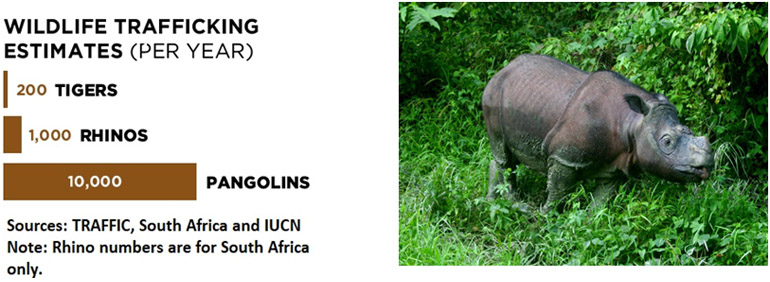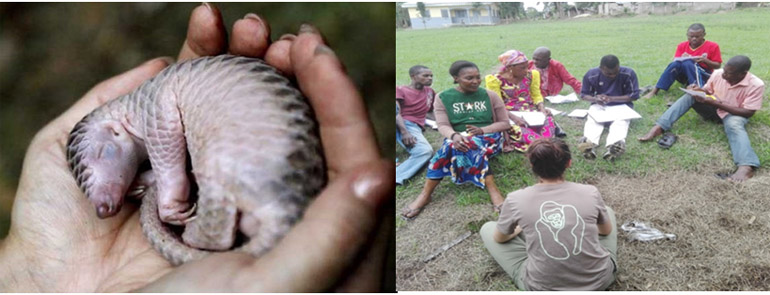|
Endangered Species International (ESI) marked five consecutive years since the last endangered gorilla, elephant, chimpanzee, and tarsier were poached in 2013 in our project areas. This exceptional success is a result of a combination of effective ESI conservation activities on the ground addressing root causes of illegal poaching, political will and government entities, ESI development of sustainable livelihood for communities, and the active involvement and support of conservation communities. “This success gives us a great hope for a better future for endangered species and their habitats. We can proudly and happily continue and expand our work for more good news and for a better planet.” said Pierre Fidenci, Director of ESI.
Thanks to these efforts, around eighty lowland gorillas now live freely in our vast project site in the Mayombe Forest of Congo. In Southern Philippines, the endangered tarsier can also regain its protected habitat without the fear of being captured. These robust protection efforts will continue on, with our goal of reaching an additional 365 days of zero endangered species poaching in all our project areas within the next five years and by extending their protection areas over other vast critical ecosystems.
As we’re celebrating our effective efforts to reduce wildlife crime, we’re also fighting the troubling rise of many other species poaching in Africa and Southeast Asia. Last year, poachers killed over 10,000 pangolins (all the eight species are threatened with extinction) largely because they are being illegally traded to China and Viet Nam. Poachers killed at least 1,338 rhinos in southern Africa in 2015—a new record and the sixth annual increase in a row. Further, poachers killed 30,000 African elephants in 2015. In Tanzania, their numbers plummeted from an estimated 109,051 in 2009 to 43,330 in 2014 because of poaching for ivory. Finally, around 250 live Asian Elephants have been smuggled from Myanmar in the past decade.
Elephants and gorillas number among a vast array of animals hit hard by a global poaching epidemic that’s emptying the world’s tropical forests, savannas, rivers, and oceans of amazing wildlife. This senseless slaughter feeds a lucrative, global black market for ivory, which jeopardizes the survival of entire animal populations, endangers the lives and livelihoods of local communities, and finances criminal organizations that undermine national and regional security.

Photo on the right: Asian Rhino is one of the most critically endangered species.
ESI is applying the strength of our passion, expertise, experience, full support of indigenous tribes and communities, our influence with partners and governments, and the passion of our supporters like you to stop the illegal killing of wildlife including non-iconic animals. We care for all animals, small or large.

Photo on the left: A pangolin victim of massive illegal poaching. Photo on the right: Endangered Species International working hand and hand with local communities to stop illegal poaching of threatened wildlife in Africa.
People, like you, around the world are standing up for these magnificent animals—and making an enormous impact by supporting ESI. Our field successes are possible because of you. We step up for species and nature. But we will only stay that way if people like you take actions to keep it that way. So, what will you do for your planet and all those animals? Join us.
Some of our projects to save endangered wildlife from massive illegal poaching:
Be a voice for endangered lemurs
Our project focus on the ring-tailed lemur population of Isalo in Madagascar to train locals to effectively monitor the protected area against illegal capture of endangered lemurs. Once the local team is well trained, we can ensure that no lemurs will be killed allowing them to prosper freely in Southern Madagascar.
Step up wild gorilla conservation and protect rainforest
ESI is actively conducting vital field conservation activities to protect gorillas and many other threatened species in the district of Kakamoeka located in the vast Mayombe Forest of the Republic of Congo. The region is home to a rich, rare and iconic biodiversity such as gorillas, chimpanzees, mandrills and forest elephants. Our surveys estimated a density of at 0.81 gorilla per km2, which is relatively important compared to some areas where indices of abundance of this primate have been studied in Congo. Threatened by poaching, logging and mining, all species found in the Mayombe forest are rapidly declining. The risk of seeing fully protected species disappear totally from the forests of this territory becomes each year more than likely if nothing is done to protect them. Such a disappearance would have irreversible consequences on the quality of the ecosystem services provided by the Mayombe forest to Congolese and the entire planet.
Halt the endangered Philippine tarsier decline by planting indigenous trees
The main threat to the endangered Philippine tarsier is poaching and the lack of natural forest (its vital natural habitat). By planting native tropical trees in Mindanao Island in the Tarsier sanctuary (509 hectares of protected land for tarsier), we can save the tarsier from becoming extinct and restore natural magnificent rainforest. All trees are planted in protected area by local communities and carefully monitored to ensure high survival rate.
No to Extinction of Saiga Antelope
The main threat to the Saiga antelope is illegal poaching for its horns (male horns are exported for the traditional Chinese medicine trade) and meat. We will provide direct law enforcement on the ground including anti-poaching measures at local levels in Mongolia. We will also intensify public awareness at schools and local communities.
More of our projects can be found here!
About us
Endangered Species International (ESI) is strongly committed to reversing the trend of human-induced species extinction, saving endangered animals, and preserving wild places! ESI uses less than 2% of its budget for management and operations. ESI won multiple Top-Rated Awards from GreatNonprofits and has reached the Platinum participation level through the GuideStar Exchange.
Related links
|











